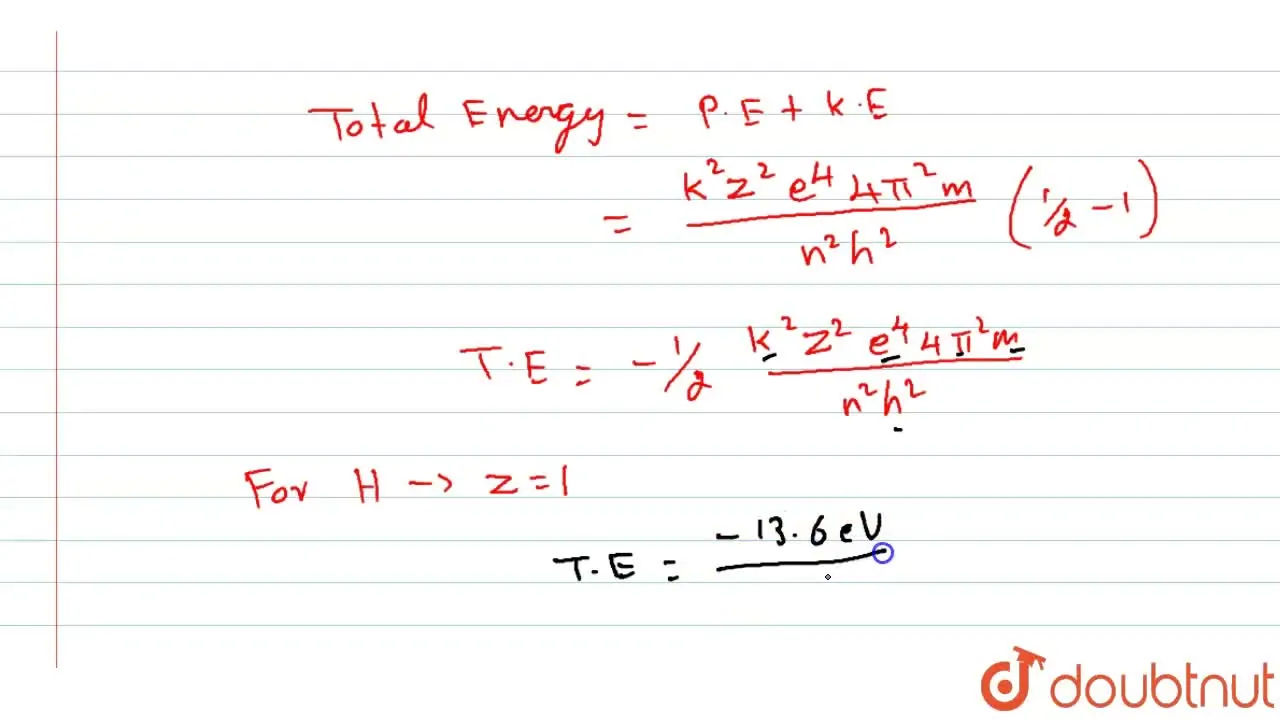Derive the energy expression for hydrogen atom using Bohr atom model.Solution in Tamil
The energy of an electron in the nth orbit
Since the electrostatic force is a conservative force, the potential energy for the nth orbit is
Un=14πε0(+Ze)(−e)rn=−14πε0Ze2rn
=−14ε20Z2me4h2n2(∵rn=ε0h2πme2n2Z)
The kinetic energy for the nth orbit is KEn=12mv2n=me28ε20h2Z2n2
This implies that Un=−2KEn. Total energy in the nth orbit is
En=KEn+Un=KEn−2KEn=−KEn
En=−me48ε20h2Z2n2
For hydrogen atom (Z = 1),
En=−me48ε20h21n2joule ....(1)
where n stands for principal quantum number. The negative sign in equation (1) indicates that the electron is bound to the nucleus.
Substituting the values of mass and charge of an electron (m and e), permittivity of free spaceε0 and Planck.s constant h and expressing in terms of eV, we get
En=−13.61n2eV
For the first orbit (ground state ), the total energy of electron is E1=−13.6eV. For the second orbit (first excited state), the total energy of elctron is E2=−3.4eV. For the third orbit(second excited state), the total energy of electron is E3=−1.51eV and so on.
Notice that the energy of the first excited state is greater than the ground state, second excited state is greater than the first excited state and so on. Thus, the orbit which is closet to the nucleus (r1) has lowest energy (minimum energy compared with other orbits). So, it is often called ground state energy (lowest energy state) . The ground state energy of hydrogen(−13.6eV) is used as a unit of energy called Rydberg(1 Rydberg = -13.6 eV).The negative value of this energy is because of the way the zero of the potential energy is defined. When the electron is taken away to an infinite distance (very far distance) from nucleus both the potential energy and kinetic energy terms vanish and hence the total energy also vanishes.
Related Playlists
- BOOK - FULL MARKSCHAPTER - ATOMIC AND NUCLEAR PHYSICSEXERCISE - Textual Evaluation Solved (Exercise)11videos
ATOMIC AND NUCLEAR PHYSICS
- BOOK - FULL MARKSCHAPTER - ATOMIC AND NUCLEAR PHYSICSEXERCISE - Additional question (Multiple Choice Question)56videos
ATOMIC AND NUCLEAR PHYSICS
- BOOK - FULL MARKSCHAPTER - ATOMIC AND NUCLEAR PHYSICSEXERCISE - Textual Evaluation Solved (Short Answer Questions)27videos
ATOMIC AND NUCLEAR PHYSICS
- BOOK - FULL MARKSCHAPTER - COMMUNICATION SYSTEMSEXERCISE - ADDITIONAL QUESTIONS (Additional problems)3videos
COMMUNICATION SYSTEMS
Similar Questions
Consider two hydrogen atoms HAandHB in ground state. Assume that hydrogen atom HA is at rest and hydrogen atom HB is moving with a speed and make head-on collide on the stationary hydrogen atom HA. After the strike, both of them move together. What is minimum value of the kinetic energy of the moving hydrogen atom HB, such that any one of the hydrogen atoms reaches one of the excitation state.
03:51View SolutionThe potential difference applied to an X-ray tube is 5kV and the current through it is 3.2 mA. Then the number of electrons striking the target per second is
01:27View SolutionWhat are cathode rays?
06:12View SolutionA radio can tune into any station in the 7.5 MHz to 12 MHz band. What is the corresponding wavelength band ?
05:09View SolutionIn Bohr's model of hydrogen atom ,
05:57View Solutionwhich of the following postulates of the Bohr model led to the quantization of energy of the hydrogen atom ?
05:09View SolutionUsing Rutherford model of atom , derive the expression for the total energy of the electron in hydrogen atom. What is the significance of total negative energy possessed by the electron ?
View SolutionDerive the energy expression for hydrogen atom using Bohr atom model.
48:36View SolutionUsing Rutherford model of atom, derive an expression for the total energy of an electron in hydrogen atom.
06:06View SolutionDerive the energy expression for hydrogen atom using Bohr atom model.
View SolutionUsing Bohr's atomic model, derive the expression for the radius of nth orbit of the revolviting electron in a hydrogen atom.
03:55View SolutionAtoms|Bohr Model Of The Hydrogen Atom
01:31View SolutionAssuming the expression for radius of the orbit, derive an expression for total energy of an electron in hydrogen atom.
08:42View SolutionUsing Rutherford model of the atom, derive the expression for the total energy of the electron in hydrogen atom. What is the significance of total negative energy possessed by the electron?
03:33View SolutionUsing Rutherford's model of the atom, derive the expression for the total energy of the electron in hydrogen atom. What is the significance of total negative energy possessed by the electron?
57:31View Solution


